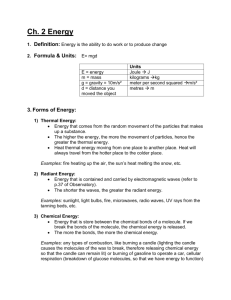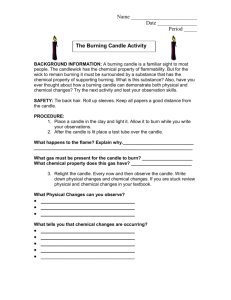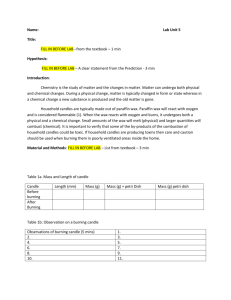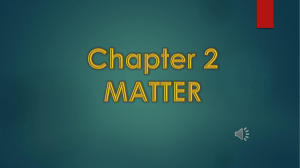handout - Valley Home Educators
advertisement
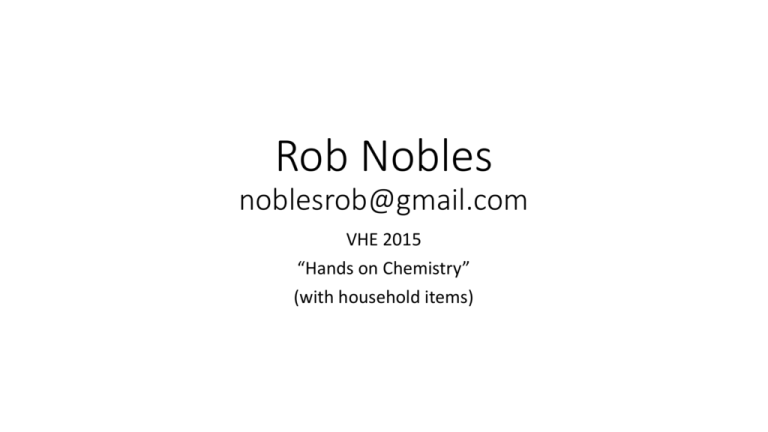
Rob Nobles noblesrob@gmail.com VHE 2015 “Hands on Chemistry” (with household items) Hands on Chemistry (with household items) 1. Density of solids and liquids 2. Separations—Chromatography and Evaporation 3. Learning to Count (MOLES) using oatmeal and candles 4. Building Molecules with Marshmallows 5. Acids and Bases—pH of common household liquids Bonus 6. Feel the Burn—calories in various foods 1. Density of solids and liquids Purpose: A—to determine the density of various metals by displacement. B—to determine the density of several liquids by use of a volumetric pipette. Procedure A—to determin the density of various metals by displacement. 1. Find the mass of each metal using an scale. Record mass of each metal to the nearest 0.01 gm 2. Fill a 50 ml or 100 ml graduated cylinder about half-way with water. Record the volume of water in milliliters. (be sure to read the bottom of the meniscus). 3. Carefully place the metal into the graduated cylinder. It works best to tip the graduated cylinder and slide the metal cylinder along the side. 4. Record the new volume of water in the cylinder. 5. Determine the mass and volume of all four metals on your table. Metal Copper pennies Aluminum foil Iron nails Gold jewelry Mass (gm) Volume (ml) Density (gm/ml) Procedure— B—to determine the density of several liquids by use of a volumetric pipette. 1. Find the mass of a small empty container to the nearest 0.01 gm. 2. Use a dropper to measure 5.0 ml of tap water into the container and determine the new mass. 3. Repeat the process for all solutions and then calculate density. (Density = mass / volume) 4. Rinse all equipment with tap water when finished. Liquid Tap Water Distilled Water Rubbing Alcohol Soda Diet Soda Others Mass of container Mass of container Mass of liquid (gm) with liquid (gm) (gm) Volume of Liquid (ml) Density (gm/ml) • Conclusion from Part A: Organize the metals from most dense to least dense. What does this tell you about their atomic structure? • Conclusion from Part B: Which solution was the most dense?___ least dense?____ • If you could float in rubbing alcohol what does that tell you about your density? 2. Separations—Chromatography and Evaporation Purpose--separate the colors in different markers using paper chromatography Procedure— • Cut a 3 cm wide strip of paper towel long enough to hang in a glass of water. Make a pencil mark 2 cm from the bottom. • Mark a chromatography paper with knowns. • Write the color of the marker on the paer in pencil. • Measure the length so the marker is not submerged in the liquid. • Tape the paper to a “hanger” so it can hang undisturbed for 30 min. • Remove and allow to dry. Chrom--Calculate Rf values. Brand and Color of Marker Distance spot 1 traveled D1 (cm) Distance spot 2 Distance solvent traveled D2 (cm) traveled Ds (cm) Conclusion: 1. Which Rf’s are most similar? Why? 2. What kind of solvent would you use for a permanent marker? Calculate Rf D1/Ds Calculate Rf D2/Ds Evaporation Purpose—to determine the % of minerals in ocean water. Procedure— 1. Weigh an empty glass container that can be heated. 2. Measure out 20.0 ml of salt water with the graduated cylinder. 3. Pour into glass container and weigh. 4. Heat on hot plate until all H2O has evaporated. 5. Be careful as you get to the end the salt will spatter and it is hot!!! 6. Allow container to cool and weigh. Trial 1 Mass of Empty glass container Mass of container and salt water Mass of salt removed Mass of salt water used Percent of salt in water (salt/salt water) *100 Average Percent Trial 2 Trial 3 3. Learning to Count (MOLES) using oatmeal and candles Purpose—To determine how many flakes of oatmeal are in a 1 gallon jar. Prodecure— Trial 1 Mass of empty weighing dish Mass of 50 flakes of oatmeal plus weighing dish Mass of 50 flakes of oatmeal Mass of all the oatmeal in the jar Solve for X flakes of oatmeal in jar Ratio: (50 flakes/ ___ gm)= (X flakes / ___ gm) Solve for X Jars to hold 1 mole of oatmeal Ratio:___ flakes / 1 jar = 6.02x1023 flakes / X jars Conclusion: How many jars would it take to hold a mole of oatmeal? (Show all calculations) Trial 2 Trial 3 PURPOSE: to burn candle wax and to determine the number of moles and molecules used up. Trial 1 PROCEDURE: 1) Mass a glass plate 2) Light a candle. Drip a little of wax on the plate. Stick candle to plate blow out candle. Find the total mass. 3) Light the candle and allow it to burn 5 minutes. Do not play with wax this will effect your results. Blow out candle and reweigh. 4) Calculate the new mass of the candle by itself. Mass a glass plate Calculate the mass of the candle by itself Mass of candle and glass plate after burning 5 min Mass of candle alone after burning 5 min Mass of the candle that burned (left) in 5 min Trial 2 Trial 3 CALCULATIONS Wax is a mixture of hydrocarbons. C25H52 can be used as a representative hydrocarbon in the mixure. The burning of wax is shown below: C25H52 + _____ O2 _____ CO2 + _____ H2O + energy a) Balance the equation. Count atoms below. ___________ carbon ____________ ___________hydrogen___________ ____________oxygen____________ b) What is the molar mass of wax? c) How many moles of wax were in the candle before it burned ? d) How many molecules are in the candle before it burned? e) How many moles of wax were used up during the burning? f)How many molecules were used up during the burning? g) How long would it take to burn 1 mole of candle? CONCLUSIONS 1) What 2 resources are used up as a candle burns? 2) What has happened to the atoms in these resources? 3) Is it possible to recover these 2 resources after they've been used? Explain 4. Building Molecules with Marshmallows (or other favorite candies) Secrets of the Periodic Table • Objectives—to help students learn Lewis Dot Structures for molecules. • Group 1 has 1 dot • Group 2 has 2 dots • Group 3 • Etc • Group 8 has 8 dots • Learn how Lewis Dot structures help us build Molecules • Examples • Li • Be • B • C • N • O • F • Ne You will need: Lots of Toothpicks and lots of mini marshmallows (or other candies) 1. Using the toothpicks and marshmallows create a water molecule. 2. Draw the lewis Dot Structure including all electrons 3. Be sure to label the atoms and the shape of the molecule Chemical formula BeF2 H2O AlCl3 NH3 CH4 Lewis Dot Structure Shape Objective 3: Learn the primary shapes of molecules Linear—BeF2 Bent—H2O Trigonal planar—AlCl3 Trigonal pyramidal—NH3 Tetrahedral—CH4 Monster Molecules for FUN Vitamin B12 5. Acids and Bases—pH of common household liquids Purpose: To determine the pH of some household liquids. Procedure: • Obtain a small amount of liquid in a container (cup or bowl) • Using pH paper dab a piece of paper in the liquid and compare the color to the color chart. • Record the pH. Solution Prediction (Acid or Base) Measured pH Discussion: Summarize your results in a couple of sentences. What types of molecules are acidic? What types of molecules are basic? Which solution had the lowest pH? _________What does that tell about the Hydrogen ion concentration? Which solution had the highest pH? _________What does that tell about the hydrogen ion concentration? Bonus 6. Feel the Burn—calories in various foods Objective—to determine the number of calories in various foods. Procedure-• Set up the apparatus as shown and weigh a food item. • Add 200 ml of water to the can and take the temp. • Burn the food, recording the maximum temp and weigh burnt food. • Repeat 3 times for each food. Food 1 Mass of Food Before burning (gm) Mass of Food After burning (gm) Temp of water before (Celsius) Temp of water after burning (Celsius) Volume of water used in can (ml) Food 1 Food 1 Food 2 Food 2 Food 2 • Calculations: • energy in food = mass of water used * specific heat * change in temp / change in mass of nut • q = (m*c* t) / (mass of nut) Food 1 Change in mass of food (gm) Change in temp of water (C) Mass of water used (kg) q=energy in food (Kcal / gm food) Average energy in food 1: _____ Average energy in food 2:______ Which food had the most energy? Food 1 Food 1 Food 2 Food 2 Food 2 Resources • PhET—University of Colorado, virtual labs • World of Chemistry—online videos • Bozeman Science—online videos

